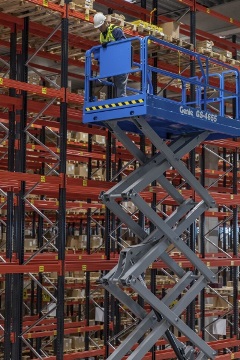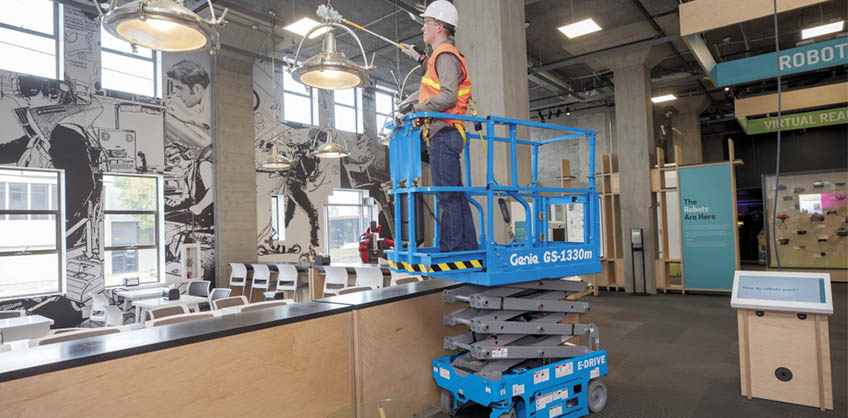How Wind Rating Requirements Impact Scissor Lift Design and Safe Use
by Michael Flanagan - Product Manager On May 7, 2020, 03:00 am
Subscribe To Aerial Pros
Filter by tags
Industry standards governing the design, use and manufacture of any aerial product will require periodic reviews, as new technologies and best practices enter the market. The updating process often includes a review of regional standards that also apply to the products being addressed. This process is currently underway in North America, with the review of the ANSI A92 (United States) and CSA B354 (Canada) standards. The previous versions of the North American standards used a representative testing scheme while the European standard uses a more prescriptive method where a design is tested to specific conditions. Both have provided a consistent benchmark for safe machine design.
Because standards set a safety level for all participants in the market, the outcome of this review and updating activity in the United States and Canada is that the standards in North America — and other regions that follow ANSI/CSA guidelines, including many countries in Asia-Pacific — are now more closely aligned with ISO standards guiding global markets like Europe, Australia and China.
Today’s ISO standards, which are in harmony regional standards like the ANSI A92 in the United States, AS 1418.10 in Australia, CSA B354 in Canada and EN280 in Europe, specifically address wind ratings, chassis angle and load capacity on these types of MEWPs (mobile elevating work platforms).To adhere to the wind rating requirements in the ISO standards, scissor lifts are now rated for either 0 mph or 28 mph (12.5 m/s) of wind, for indoor (0 mph wind) or outdoor (up to 28 mph of wind) use. This categorization is based on how the standards evaluate the impact of wind on these machines.
in the United States, AS 1418.10 in Australia, CSA B354 in Canada and EN280 in Europe, specifically address wind ratings, chassis angle and load capacity on these types of MEWPs (mobile elevating work platforms).To adhere to the wind rating requirements in the ISO standards, scissor lifts are now rated for either 0 mph or 28 mph (12.5 m/s) of wind, for indoor (0 mph wind) or outdoor (up to 28 mph of wind) use. This categorization is based on how the standards evaluate the impact of wind on these machines.
In previous versions of the ANSI and CSA standards, there was no distinction between the use of scissor lifts indoors or outdoors. MEWP manufacturers like Genie designed their scissor lifts to be operated anywhere if the machine was not be raised when wind speeds exceeded 28 mph (12.5 m/s). In fact, Genie further advised users that if wind speeds exceed 28 mph (12.5 m/s) when the machine was raised, the operator must immediately lower it and discontinue operation until the wind fell below that speed. Genie also stated that an operator must not operate the machine in strong or gusty winds, or increase the machine’s platform surface area or the load, as increasing the area exposed to the wind would decrease machine stability.
Today, using a calculations-based approach, ISO standards state that the use of scissor lifts indoors or outdoors is based on several factors, including side force, chassis tilt, wind rating and platform load sensing.
Following these global standards, provisions now exist for MEWPs to only be used indoors, where they are not subject to wind loads. These provisions allow for the development of smaller, lighter-weight MEWPs bearing an “indoor only” rating; such MEWPs would not be subjected to the typical wind speed limitations imposed on MEWPs used outdoors.
This requirement has the most effect on small portable products and scissor lifts. While indoor-only MEWPs may be lighter weight, they will be limited to work in areas not impacted by wind and can complicate rental fleet management. Machines rated for outdoor use will be designed and manufactured for use in wind as limited by the ISO standards.
The ramifications of adhering to these requirements means that rental stores need to make decisions about the mix of indoor-only versus outdoor-use machines in their fleets. Learning from markets like Europe that have had these requirements in place for several years, mixed fleets can get very confusing for both the rental operations team, as well as their customers.
To reduce confusion in the marketplace, as well as to increase productivity, Genie has responded to the ISO standards requirements by designing and manufacturing scissor lifts for safe use in indoor and outdoor applications, enabling dual zone operation. The incorporation of dual zone operation:
- Eliminates the complexity of having to manage a fleet of indoor-use only scissor lifts for its rental customers,
- And, minimizes the impact to machine performance — like ramp climbing and runtime — and improved jobsite access— by reducing floor loading and machine weight.
Adhering to the ISO standards, Genie scissor lifts manufactured for dual-zone operation are available to customers globally starting in March 2020.


